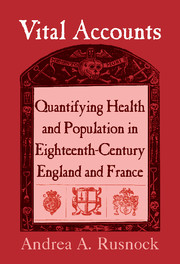Book contents
- Frontmatter
- Contents
- List of Illustrations
- Acknowledgments
- Vital Accounts
- Introduction
- 1 A New Science: Political Arithmetic
- PART ONE SMALLPOX INOCULATION AND MEDICAL ARITHMETIC
- PART TWO MEDICAL ARITHMETIC AND ENVIRONMENTAL MEDICINE
- PART THREE POLITICAL ARITHMETIC
- Conclusion
- Bibliography
- Index
- Titles in the series
1 - A New Science: Political Arithmetic
Published online by Cambridge University Press: 15 October 2009
- Frontmatter
- Contents
- List of Illustrations
- Acknowledgments
- Vital Accounts
- Introduction
- 1 A New Science: Political Arithmetic
- PART ONE SMALLPOX INOCULATION AND MEDICAL ARITHMETIC
- PART TWO MEDICAL ARITHMETIC AND ENVIRONMENTAL MEDICINE
- PART THREE POLITICAL ARITHMETIC
- Conclusion
- Bibliography
- Index
- Titles in the series
Summary
[Algebra] came out of Arabia by the Moores into Spaine and from thence hither, and W[illiam] P[etty] hath applyed it to other than purely mathematicall matters, viz.: to policy by the name of Politicall Arithmetick, by reducing many termes of matter to termes of number, weight, and measure, in order to be handled mathematically.
William PettyThe origin of quantitative studies of population is most often traced to a single book: John Graunt's Natural and Political Observations Made upon the Bills of Mortality published in 1662. In this modest volume, Graunt, a London tradesman, argued that “Trade and Government may be made more certain and Regular” through the application of arithmetic, and that knowledge of “how many People there be of each Sex, State, Age, Religion, Trade, Rank, or Degree, &c.” provided a fair method “to balance Parties and Factions both in Church and State.” Writing in the immediate aftermath of the English Civil War, Graunt was keenly aware of the suffering caused by religious intolerance and economic turmoil. He also felt the widespread desire for order and stability after Charles II's ascension to the throne. Through quantification, Graunt sought to construct a new form of knowledge that could provide a trustworthy resource for reducing conflict, maintaining political equilibrium, and cultivating commercial prosperity.
Graunt's friend and patron William Petty fervently embraced the new project and coined a name for Graunt's method: political arithmetic. Petty shared Graunt's confidence in the certainty and regularity of mathematics.
- Type
- Chapter
- Information
- Vital AccountsQuantifying Health and Population in Eighteenth-Century England and France, pp. 15 - 40Publisher: Cambridge University PressPrint publication year: 2002



